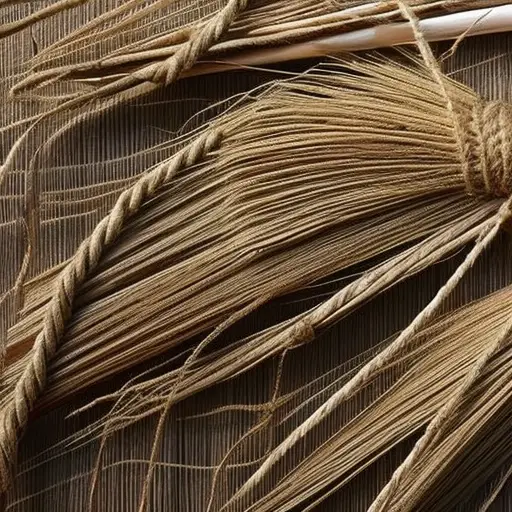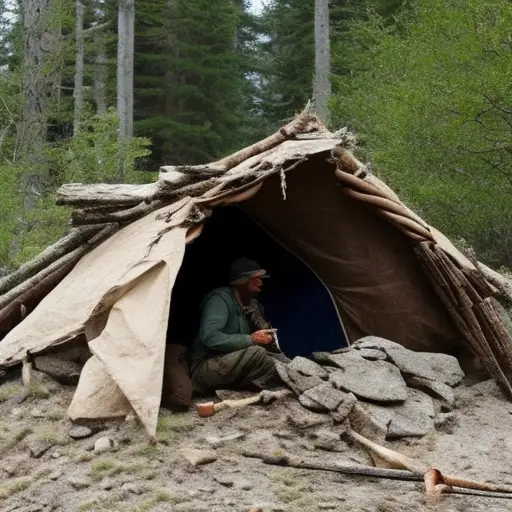How to Make a Natural Bed in the Wilderness

In the vast expanse of the untamed wilderness, finding comfort amidst the rugged terrain can be a challenge. However, with the right knowledge and a touch of resourcefulness, one can create a natural bed that blends seamlessly with nature’s offerings.
This article serves as a practical guide, providing concise and informative steps on how to construct a cozy sleeping surface using materials found in the wild.
Embrace the harmony of the outdoors, and indulge in a restful night’s sleep under the stars.
Selecting the Right Location
When selecting the right location for your natural bed in the wilderness, it is important to consider factors such as safety, comfort, and protection from the elements. Finding water sources and protecting against wildlife are also crucial aspects to keep in mind.
Firstly, the proximity to a water source is essential. Look for rivers, streams, or lakes nearby that can provide you with a clean and reliable water supply. Having easy access to water will ensure your hydration needs are met without having to venture too far from your sleeping area.
Additionally, it is crucial to protect yourself against wildlife. Choose a location that is away from areas where animals may frequent, such as game trails or water sources. Avoid setting up camp near bushes or dense vegetation, as they may attract animals seeking shelter or food. To further protect yourself, consider hanging your food in a bear-resistant bag or using bear canisters.
Gathering Natural Bedding Materials
To gather the necessary natural bedding materials for your wilderness bed, carefully collect a variety of soft leaves, grasses, and mosses in the surrounding area. These materials will provide comfort and insulation during your night in the wilderness. Here are some tips for finding alternative bedding and making the most of the resources available:
- Look for soft leaves such as broad-leafed plants or ferns. These leaves will provide a cushioning effect and help create a comfortable sleeping surface.
- Grasses can also be a great addition to your bedding. Look for long, soft grasses that are not prickly or coarse. These can help add extra padding and insulation.
- Mosses are another excellent option. They are soft, absorbent, and provide excellent insulation. Look for patches of moss growing on rocks or near water sources.
If you are unable to find enough natural materials, consider using animal fur as a bedding alternative. Animal fur, like moss, offers excellent insulation and can provide extra warmth during colder nights. Look for fur left behind by animals on trees or bushes.
Once you have gathered your natural bedding materials, it is time to prepare the sleeping surface and ensure a comfortable night’s sleep in the wilderness.
Preparing the Sleeping Surface
The preparation of the sleeping surface in a natural bed in the wilderness involves ensuring its levelness and stability. To achieve this, it is crucial to select appropriate materials and maintain the bed properly.
When it comes to selecting materials, it is important to choose ones that are readily available in the wilderness. Leaves, grass, moss, and soft branches can all be used to create a comfortable and insulating sleeping surface. It is essential to avoid materials that may be sharp or contain allergens.
Once the materials have been gathered, they should be spread evenly over the chosen area to create a level surface. It is important to remove any rocks, sticks, or other debris that could cause discomfort or instability.
Additionally, regularly maintaining the bed is essential to ensure its longevity. This includes regularly replacing any worn out or compacted materials to maintain its comfort and insulation.
By following these steps, you can create a sleeping surface in the wilderness that is both level and stable, providing a comfortable night’s sleep.
Now, let’s move on to the next step: building a supportive base.
Building a Supportive Base
To create a stable and durable natural bed in the wilderness, it is essential to build a supportive base using sturdy materials and proper construction techniques. The supportive base serves as the foundation for the bed and ensures a comfortable and secure sleeping surface.
Here are some key steps to consider when building a supportive base:
-
Selecting appropriate materials: Choose materials that are readily available in the wilderness and can withstand the weight and pressure exerted by the sleeper. Sturdy branches or logs can be used as the primary support beams, while smaller sticks or stones can be used to fill in gaps and create a level surface.
-
Creating a stable foundation: Start by clearing the area of any rocks, debris, or vegetation that could cause discomfort or instability. Next, position the support beams parallel to each other, ensuring they are securely anchored in the ground. It is important to space the beams evenly and at a distance that accommodates the sleeper’s body size and weight.
-
Proper construction techniques: Use lashings or natural cordage to secure the support beams together, providing additional stability and strength. Ensure that the lashings are tight and secure to prevent any movement or shifting during use. Finally, test the stability of the base by applying pressure and adjusting as necessary to create a firm and level surface.
Adding Cushioning and Insulation
When it comes to adding cushioning and insulation to your natural bed in the wilderness, there are a few key points to consider.
First, using natural materials such as leaves, moss, or grass can provide effective insulation and improve sleeping comfort. These materials can be layered on top of your supportive base to create a soft and insulating surface.
Additionally, consider incorporating a layer of animal fur or a blanket for extra warmth during colder nights.
Natural Materials for Insulation
Using natural materials for insulation is essential when creating a comfortable and warm bed in the wilderness. Natural insulation provides several benefits, including enhanced warmth and a more eco-friendly approach. Here are three natural materials that can be used for insulation:
-
Dry leaves: Collecting dry leaves and placing them between the layers of your bed can provide excellent insulation. They trap air and create a barrier against the cold ground.
-
Pine needles: Pine needles are another great option for insulation. They are readily available in many wilderness areas and provide a cushioning effect while also retaining warmth.
-
Moss: Moss can be used as a natural cushioning material, adding comfort to your bed. It also acts as an insulator, helping to retain heat and keep you warm throughout the night.
Improving Sleeping Comfort
One way to enhance sleeping comfort in the wilderness is by incorporating additional cushioning and insulation.
By improving sleep quality and creating a natural sleep environment, you can ensure a more restful night’s sleep.
Adding cushioning to your bed can be achieved by using natural materials such as leaves, moss, or soft grass. These materials provide a layer of padding that helps to alleviate pressure points and provide support for your body.
Insulation is crucial for regulating temperature and keeping you warm during cold nights. Natural materials like pine needles or straw can be used to create a layer of insulation between you and the ground.
By adding cushioning and insulation, you can create a more comfortable sleeping surface that promotes a good night’s sleep.
This sets the foundation for making it cozy for a good night’s sleep by incorporating additional elements of comfort.
Making It Cozy for a Good Night’s Sleep
To ensure a good night’s sleep in the wilderness, it is important to consider essential sleep accessories and optimal sleeping arrangements.
Essential sleep accessories may include a comfortable pillow, a warm blanket or sleeping bag, and earplugs to block out any noise.
Optimal sleeping arrangements involve finding a level and dry spot, away from rocks and tree roots, and using natural materials like leaves or moss for additional cushioning and insulation.
Essential Sleep Accessories
For a truly comfortable night’s sleep in the wilderness, consider investing in a variety of essential sleep accessories that will help create a cozy and restful environment. Here are three must-have items to enhance your sleeping experience:
-
Sleeping Pad: A sleeping pad provides insulation and cushioning between your body and the ground. It helps to regulate your body temperature and offers added comfort, especially on uneven terrain.
-
Pillow: While it may seem unnecessary, a pillow can greatly improve your sleep quality. Opt for a lightweight, compressible pillow that provides adequate neck support for a restful night’s sleep.
-
Sleeping Bag Liner: A sleeping bag liner not only adds an extra layer of warmth but also keeps your sleeping bag clean. It is a great alternative to a sleeping bag, especially in warmer weather when a full sleeping bag may be too hot.
Optimal Sleeping Arrangements
To ensure a good night’s sleep in the wilderness, it is crucial to set up optimal sleeping arrangements that prioritize comfort and coziness. Selecting suitable terrain for your bed is essential. Look for flat, dry ground that is free from rocks, roots, and other uncomfortable obstacles. Additionally, consider alternative bedding options that can enhance your sleeping experience. One option is to use a camping hammock, which provides a comfortable and elevated sleeping surface while also keeping you off the ground. Another option is to use an inflatable sleeping pad or a foam sleeping mat, which can provide insulation and cushioning. Lastly, don’t forget to bring a warm and cozy sleeping bag or quilt to keep you snug throughout the night. Prioritizing comfort and coziness will ensure a restful night’s sleep in the wilderness.
| Terrain Selection | Alternative Bedding Options |
|---|---|
| Flat and dry ground | Camping hammock |
| Free from obstacles | Inflatable sleeping pad |
| Foam sleeping mat | |
| Warm and cozy sleeping bag | |
| Quilt |
Frequently Asked Questions
How Do I Protect Myself From Insects and Bugs While Sleeping in a Natural Bed in the Wilderness?
To protect yourself from insects and bugs while sleeping in a natural bed in the wilderness, it is essential to use insect repellent and incorporate natural remedies such as essential oils or citronella candles to deter them.
Can I Use Man-Made Materials to Enhance the Comfort of My Natural Bed?
Yes, man-made materials can be used to enhance the comfort of a natural bed in the wilderness. By incorporating items such as foam padding or inflatable mattresses, one can create a more comfortable sleeping surface.
How Can I Ensure That My Natural Bed Is Waterproof and Can Withstand Rain or Damp Conditions?
To ensure a natural bed is waterproof and withstands rain or damp conditions, one can employ various waterproofing techniques such as using natural oils or wax. Additionally, alternative natural bedding materials like straw or leaves can help prevent moisture retention.
Are There Any Specific Guidelines to Follow When Selecting Natural Bedding Materials to Avoid Allergic Reactions?
When selecting natural bedding materials to prevent allergic reactions, it is important to consider factors such as hypoallergenic properties, breathability, and resistance to dust mites. Conduct thorough research and choose materials that suit your specific needs and preferences.
What Should I Do With My Natural Bed After Use to Minimize Environmental Impact?
To minimize environmental impact after using a natural bed, consider upcycling options such as repurposing the materials for other purposes or donating them. Composting the materials is also a sustainable solution.
Conclusion
To create a natural bed in the wilderness,
select a suitable location and gather natural bedding materials.
Prepare the sleeping surface by
building a supportive base and adding cushioning and insulation.
Finally, make it cozy for a good night’s sleep.
Remember, finding comfort in the wild is like finding a needle in a haystack,
but with these techniques, you can rest easy knowing you’ve crafted a comfortable haven amidst nature’s embrace.





